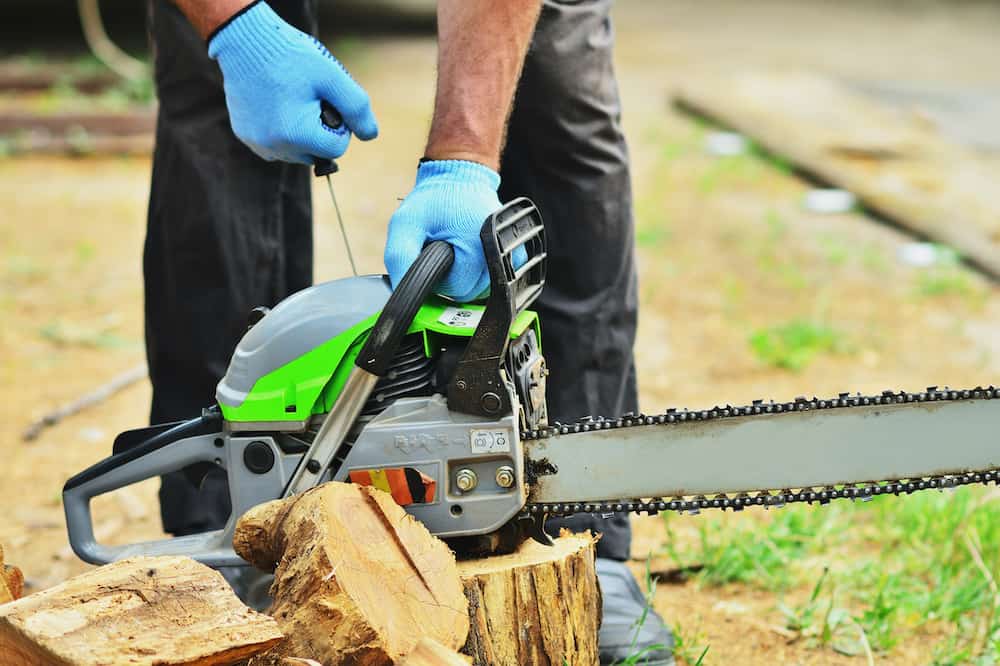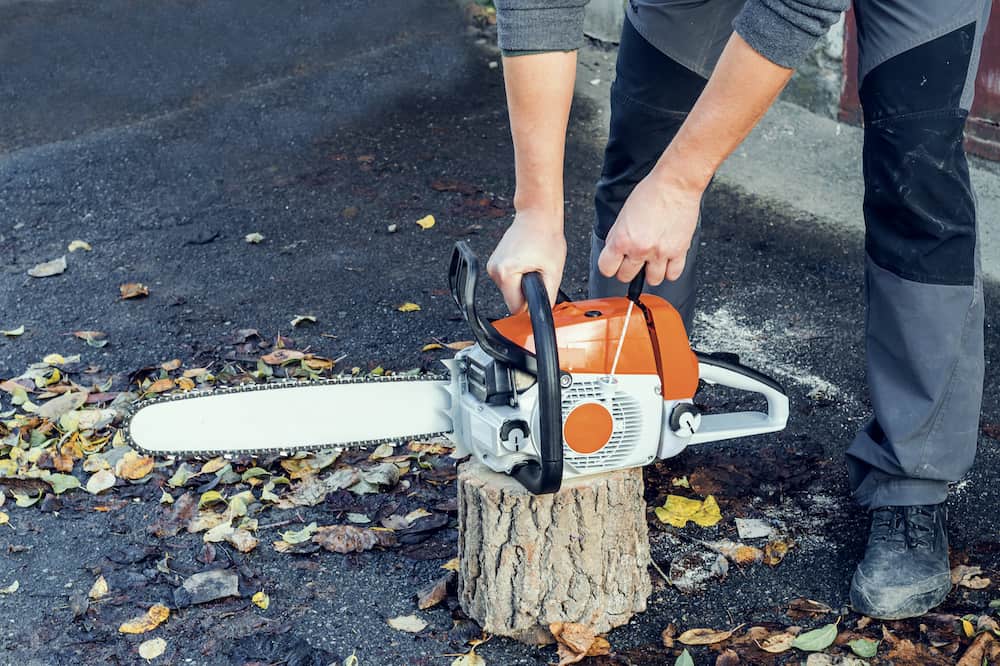Learning how to start a chainsaw seems simple enough, but it can be challenging when running into problems.
Whether you own an electric or gas chainsaw, there are specific steps you need to follow. With the help of our step-by-step instructions, you’ll safely and quickly get to starting a chainsaw.
How to start a chainsaw
You can use a chainsaw for tree felling, bucking, limbing, pruning, harvesting firewood, and more.
The answer to, “What is the proper way to start a chainsaw?” depends on the type of chainsaw you own. Gas-powered models have a significantly different procedure than electric, and often are more time-consuming.
Regardless of the type of chainsaw you own, you must operate the tool safely. Some of NASA’s recommended personal protective equipment for using a chainsaw includes:
- ANSI-approved hard hat
- Ballistic nylon pants
- ANSI-approved work boots
- Hearing protection (110 dBA minimum)
- ANSI-approved safety goggles
Be sure to always turn off the chainsaw before refueling it. In addition, do not fuel overheated saws.
How to Start a Gas Chainsaw
When starting a gas-powered chainsaw, you’ll first want to figure out what starting position is the most comfortable for you to use for your safety.
You’ll likely find that starting the chainsaw on the ground is the simplest. Another common position is to start it between your legs.
Starting a Cold Engine
Starting a cold engine is slightly different from a hot one since there are a couple of additional steps, namely:
-
Activate the Chain Brake
Always make sure the chain brake is engaged when learning how to start a chainsaw.
Annually, in the USA, nearly 36,000 people are treated in hospitals for chainsaw-related injuries. This feature helps to make sure the chain doesn’t move and cause torque while you’re starting.
-
Prime the Carburetor
Next, you’ll want to prime your carburetor using the priming features available to you.
Most gas-powered chainsaws will have a fuel pump or air purge valve that you depress with your finger.
You’ll want to push this button a couple of times until you can tell the fuel is entering the carburetor.
With most models, the primer bulb should feel stiff under your finger, and you’ll be able to see fuel.
-
Activate the Choke
Depending on your chainsaw’s model, you may have to press a decompression valve.
To open the choke, you may have to move a lever or knob to the cold start function (fully open). This part’s responsibility is to ensure the air and fuel mixture is regulated as it enters the engine.
-
Start the Chainsaw
You’ll want to maintain a firm grip on the handlebar, keeping the chain brake engaged. Using the starting cord, pull it once in with a smooth motion that isn’t too hard or too fast.
You’ll likely have to pull a couple of times until the engine fires. Once the engine fires, you can push the choke to half-throttle and allow the saw to start.
Make sure that you rev the engine so that it goes into idle.
-
Idle and Close the Choke
It’s recommended you let the chainsaw idle for 30 seconds to help prevent it from stalling. After 30 seconds, you can close the choke so that it’s fully closed, and your chainsaw should still run.
When it comes time to cut, make sure you disengage the chain brake.
Starting a Warm Engine
You might have to know how to start a warm engine if you take a break in between your projects or if you need to refuel. Be sure you have enough gas before starting the chainsaw so you won’t have to stop and start again.
Fortunately, you won’t have to worry about priming the carburetor again because the engine should already be primed.
The only step starting a chainsaw with a warm engine is to start the handle using the starting cord. The engine will come to life with one to two pulls, and you can get back to the task at hand.
How to Start an Electric Chainsaw
One of the main reasons homeowners transition to electric chainsaws is that they’re easier to use. You won’t have to worry about priming anything or managing the fuel-to-air ratio reaching the engine.
1. Connect to Power
If you have a corded electric chainsaw, you’ll first need to connect to power, whether it be an extension cord or a generator.
For cordless models, you will want to make sure the battery is fully charged before use.
2. Enter the Starting Position
You’ll want to hold the chainsaw on the ground, making sure the bar is away from any obstructions and obstacles. Also, you should be positioned behind the bar, rather than in front of it.
3. Engage the Chain Brake
As with gas-powered chainsaws, ensure the chain brake is engaged before starting.
You might need to refer to your manual to determine where the brake is and whether it’s a button or switch.
4. Start the Motor
With the chain brake, you can pull the trigger or push the start button on the chainsaw to bring the motor to life.
At this point, your electric chainsaw should be ready to use.

What is the easiest chainsaw to start?
As you can tell, electric chainsaws are the easiest chainsaws to start, whether you’re working in hot or cold weather. You don’t have to worry about fuel and oil mixtures, fuel and air, or making sure the carburetor is primed.
Your only responsibilities are to make sure it’s connected to power. It’s also important that the chain has adequate lubrication.
How do you start a chainsaw that won’t start?
Sometimes, even if you do all of the above steps correctly, your chainsaw might not start. This issue could be a result of improper maintenance or if you didn’t prepare the chainsaw properly.
Use these tips to help you troubleshoot the most common problems with starting a chainsaw.
How to fix a chainsaw that won’t start
If you’re dealing with a chainsaw that won’t start, there are a couple of problems to consider.
Clogged Carburetor
By far, the most common reason for this issue is a clogged carburetor. Clogs can happen when you leave fuel in the chainsaw for an extended period, such as over the winter.
Some of the fuel’s ingredients evaporate, which leaves a sticky substance behind to clog the carburetor.
Fortunately, all you have to do is clean the carburetor with a specialty cleaner. However, if the chainsaw still won’t start afterward, you might need to replace the entire unit.
Defective Ignition Coil
A faulty ignition coil can prevent a voltage from being sent to the engine once you turn the chainsaw on.
Likely, you won’t bring the motor to life if you have a faulty ignition coil. To determine if this is the issue, check the spark plug in your chainsaw.
If the spark plug doesn’t look damaged, then you should have the coil professionally tested.
Broken Starter Pulley
You can quickly tell if the starter pulley is broken on your chainsaw because it won’t recoil after being pulled. With this issue, you have to replace the pulley; otherwise, the motor won’t turn over to start.
What is the ratio for mixing gasoline and oil?
The gas and oil ratio for your chainsaw will be dependent on the model you own. It’s crucial you first consult your owner’s manual before mixing fuel and oil.
For example, STIHL gas-powered equipment needs a 50:1 ratio, while McCulloch chainsaws need 40:1.
How do you clean a chainsaw chain?
The best cleaning solution to keep your chainsaw chain clean is ammonia mixed with water.
You’ll want to mix a cup of ammonia per gallon of water and submerge the chain, letting it soak for 15 minutes.
Once finished, use a soft-bristled toothbrush to work away any debris stuck in the chain.
You must wear gloves for this task to make sure you protect your skin. You will also want to make sure you rinse the chain a second time to get rid of excess ammonia and dirt.
Before using or starting a chainsaw, oil the chain with industrial lubricant, making sure it can sit in the oil for three hours.
What is the proper way to start a chainsaw
Knowing about starting a chainsaw and safe operations are essential. When choosing a chainsaw, consider horsepower, chain type, bar length and safety features. Choose a chainsaw with built-in safety features which will make it safer to start and use. You’ll also need personal protective gear.
If you have a gas-powered model, be sure it has gas before you begin. It must be off before refilling.
Size up your project before starting a chainsaw and cutting.
Whether you are felling trees or bucking (cutting tree trunks), you will need to know how to start a chainsaw and operate it safely. Using these easy-to-follow steps and tips, you’ll be prepared to start your chainsaw at any time.
With proper care and maintenance, you’ll have a reliable tool for any rural property challenges you might experience.
Related Articles:

